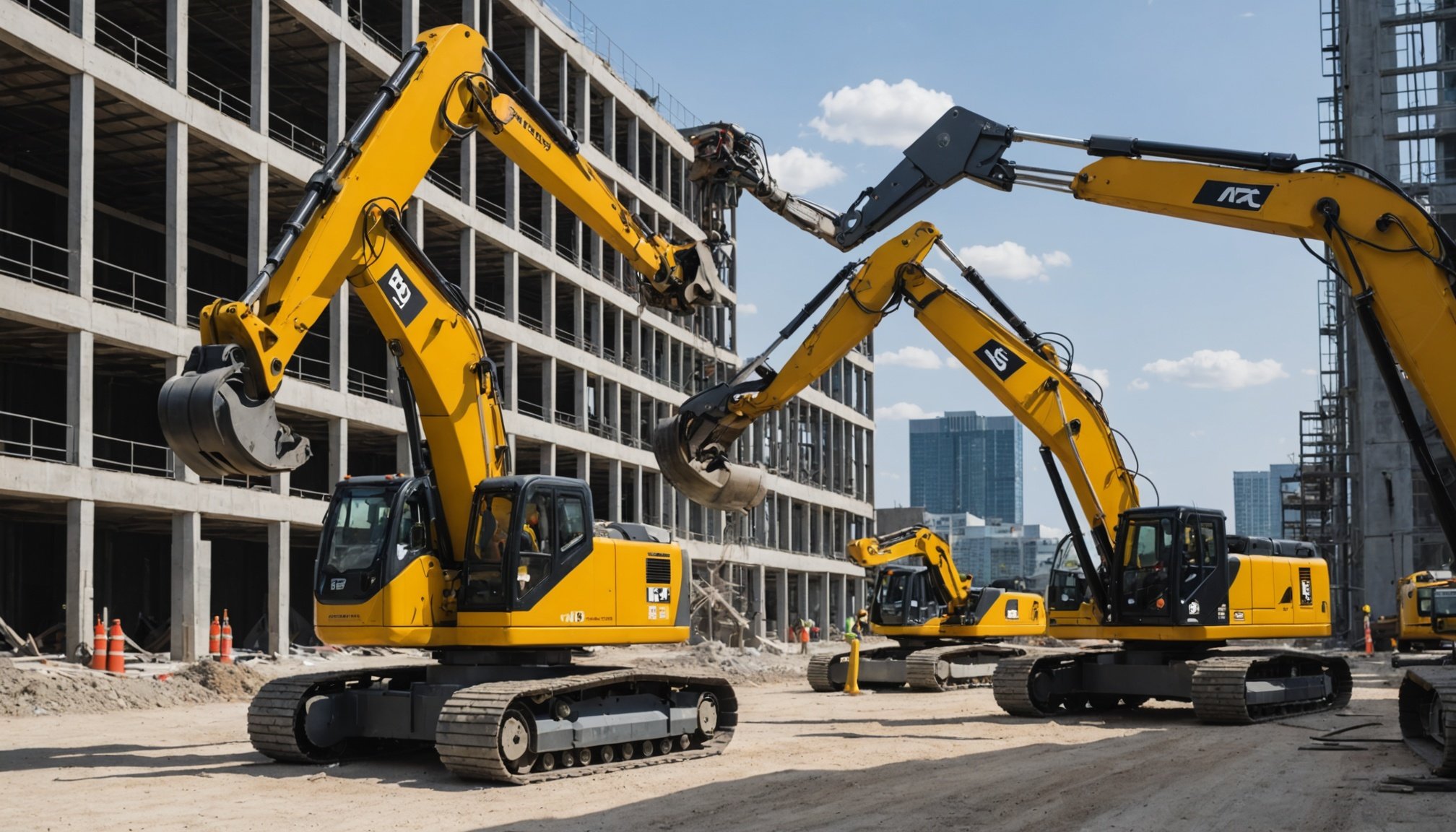Transforming Real Estate: The Role of Robotics in Advancing Construction and Maintenance Innovation
The construction industry, valued at $12.74 trillion globally, is on the cusp of a revolutionary transformation, driven largely by the integration of robotics and automation. These technologies are not only enhancing efficiency and safety but also paving the way for more sustainable and innovative building practices.
The Rise of Construction Robotics
Construction robotics involves the use of robots and automation to assist or replace traditional human labor in building projects. This field has seen significant growth in recent years, particularly as the industry grapples with challenges such as labor shortages, safety concerns, and the need for increased productivity.
Also read : Designing bike-friendly urban spaces: innovative approaches for planners in new developments
Key Types of Construction Robots
-
Autonomous Construction Vehicles: These include drones, excavators, and trucks that are used for site surveys, material handling, and other tasks. For instance, Built Robotics’ autonomous excavator can dig trenches, move earth, and transport materials without human intervention, reducing the risk of accidents and enhancing productivity[1].
-
Robotic Surveyors: Drones and robots equipped with high-resolution cameras and sensors are used for site inspections and mapping. They can access hazardous areas, reduce human risk, and provide accurate and detailed data for project planning and monitoring[1].
-
Bricklaying and Material Handling Robots: Automated bricklaying systems can lay bricks faster and more accurately than human workers. These robots also handle materials efficiently, reducing the need for manual labor and minimizing errors[1].
Advancements in AI and Machine Learning
The integration of artificial intelligence (AI) and machine learning into construction robotics is a game-changer. These technologies enable robots to adapt to new tasks, identify and differentiate between various materials, and optimize their functionality in real-time.
Real-Time Decision Making
AI systems equipped with sensors continuously monitor various parameters on the construction site, such as environmental conditions, material usage, and structural integrity. Drones provide aerial perspectives and detailed mapping capabilities, allowing robots to adjust their actions in real-time to ensure that construction activities align with sustainable practices.
For example, a drone might identify an unexpected obstacle, prompting the intelligent system to reroute machinery or adjust the workflow without human intervention. This real-time decision-making capability is crucial for maintaining efficiency, safety, and sustainability on construction sites[2].
Benefits of Automation in Building
Automation in building offers several significant benefits that contribute to sustainability and efficiency in the construction sector.
Enhanced Efficiency and Precision
Automation accelerates construction processes, enabling projects to be completed up to 50% faster than traditional methods. This reduction in project time also translates to lower labor costs, with a reported 30% decrease. Additionally, automation enhances safety by minimizing human exposure to hazardous tasks, reducing accidents by 35%[2].
Sustainability and Energy Efficiency
Automation plays a central role in reducing the environmental footprint of construction projects. By precisely controlling and monitoring building processes, automation minimizes unnecessary energy use, contributing to a 20% reduction in energy consumption. This not only supports environmental sustainability but also aligns with global efforts to combat climate change[2].
Future Challenges and Opportunities
While the adoption of construction robotics offers numerous benefits, it also comes with several challenges and opportunities that need to be addressed.
High Upfront Costs and Skill Gaps
One of the primary hurdles is the high upfront cost of buying and integrating robotic systems. This can be mitigated through financing options, government incentives, and highlighting the long-term savings from increased productivity and lower labor costs. Another challenge is the lack of skilled workers to operate and maintain these systems, which can be resolved by offering training programs and collaborating with educational institutions[1].
Regulatory and Safety Concerns
Robots must meet industry standards and safety rules, requiring collaboration between manufacturers, construction companies, and regulators to set clear guidelines and conduct regular safety checks. Public perception is also a factor, as some worry about job losses. However, by demonstrating how robotics can improve worker safety, complement human labor, and create new job opportunities in robot management and maintenance, these concerns can be alleviated[1].
Case Study: Skyline Robotics and Alimak Group Partnership
The partnership between Skyline Robotics and Alimak Group is a prime example of how robotics is transforming the construction and maintenance landscape.
Next-Generation Automated Building Maintenance Units (BMUs)
Skyline Robotics, known for its flagship product Ozmo, the world’s first high-rise window-cleaning robot, has partnered with Alimak Group to develop next-generation automated BMUs. This collaboration combines Alimak’s expertise in vertical access solutions with Skyline’s deep-tech robotics expertise, setting a new standard for architectural and asset management industries[3][4][5].
Key Features of the Partnership
- Cutting-Edge Automation: The integration of Ozmo technology with Alimak’s BMUs creates a fully autonomous solution for high-rise window cleaning, providing valuable data for building asset management.
- Sustainability and ESG Compliance: The partnership aligns with growing ESG (Environmental, Social, and Governance) requirements, ensuring compliance while reducing the environmental footprint of facade maintenance.
- Operational Excellence: By integrating advanced AI into BMU systems, the partnership sets a new benchmark for facade access innovation and operational excellence.
Philippe Gastineau, Senior Executive VP at Alimak Group, noted, “By automating BMUs, we are redefining how buildings are maintained while supporting architects and developers in creating innovative, sustainable structures.”[4]
Infrastructure Monitoring and Repair
Robots are also making a significant impact in infrastructure monitoring and repair, extending the lifespan of buildings and reducing the need for extensive repairs.
Real-Time Problem Solving
These advanced robots leverage cutting-edge technologies to detect and repair issues with remarkable accuracy. For example, they can fill potholes and ensure the safety of streets, minimizing environmental impact and preventing problems before they escalate[2].
Advanced Materials and Continuous Monitoring
Robots use new composites and engineered materials to enhance durability and efficiency in repairs. Continuous monitoring allows these robots to patrol infrastructure, ensuring timely and consistent maintenance, and saving resources in the process[2].
Practical Insights and Actionable Advice
For construction companies looking to adopt robotics and automation, here are some practical insights and actionable advice:
Assess Your Needs and Budget
Before investing in robotic systems, assess your specific needs and budget. Consider the long-term savings and the potential for increased productivity and safety.
Invest in Training Programs
To address the skill gap, invest in training programs for your workforce. Collaborate with educational institutions to create specialized courses that prepare workers for the new technologies.
Address Regulatory and Safety Concerns
Ensure that your robotic systems meet industry standards and safety rules. Collaborate with regulators and manufacturers to set clear guidelines and conduct regular safety checks.
Communicate the Benefits
Educate your workforce and stakeholders about the benefits of robotics, including improved safety, increased productivity, and new job opportunities in robot management and maintenance.
The integration of robotics and automation in the construction industry is a transformative force that promises to revolutionize how buildings are built and maintained. As technology continues to evolve, the potential for greater sustainability, efficiency, and safety in construction practices becomes increasingly achievable.
Market Projections
The facade maintenance automation market is expected to grow at a CAGR of over 12% between 2024 and 2030, driven by technological advancements and increasing adoption of smart building practices. The global construction robotics market, valued at $168.2 million in 2022, is expected to reach $774.6 million by 2032[1][5].
As Michael Brown, CEO of Skyline Robotics, stated, “We are leading a new era of automated facade access. Our exclusive partnership with Alimak Group further extends our vision to own the facade.”[4]
In conclusion, the future of real estate and construction is undoubtedly tied to the advancements in robotics and automation. By embracing these technologies, the industry can achieve notable reductions in its environmental footprint while maintaining high standards of efficiency and safety.
Table: Comparison of Traditional and Automated Construction Methods
| Aspect | Traditional Methods | Automated Methods |
|---|---|---|
| Efficiency | Projects completed within traditional timelines | Projects completed up to 50% faster |
| Labor Costs | Higher labor costs due to manual labor | Lower labor costs by up to 30% |
| Safety | Higher risk of accidents and injuries | Reduced accidents by up to 35% |
| Energy Consumption | Higher energy consumption due to manual processes | Reduced energy consumption by up to 20% |
| Material Waste | Higher material waste due to human error | Reduced material waste through precise control and monitoring |
| Real-Time Decision Making | Limited real-time data and decision-making capabilities | Real-time data collection and decision-making capabilities |
| Infrastructure Monitoring | Manual monitoring and repair processes | Autonomous monitoring and repair processes |
Detailed Bullet Point List: Benefits of Robotics in Construction
-
Enhanced Efficiency:
-
Projects completed up to 50% faster
-
Continuous operation without breaks or downtime
-
Optimized routes and tasks to minimize time and resources
-
Improved Safety:
-
Reduced human exposure to hazardous tasks
-
Minimized risk of accidents and injuries
-
Access to areas that may be unsafe for human workers
-
Increased Precision:
-
Accurate and detailed data collection
-
Precise control and monitoring of building processes
-
Reduced human error in tasks such as bricklaying and material handling
-
Sustainability:
-
Reduced energy consumption by up to 20%
-
Minimized material waste through precise control and monitoring
-
Extended lifespan of buildings and infrastructure through real-time monitoring and repair
-
Real-Time Decision Making:
-
Continuous monitoring of various parameters on the construction site
-
Real-time data collection and analysis
-
Immediate adjustments to workflows based on real-time data
-
Environmental Benefits:
-
Reduced carbon footprint through optimized processes
-
Minimized environmental impact through timely and consistent maintenance
-
Compliance with ESG (Environmental, Social, and Governance) requirements
By understanding and leveraging these benefits, the construction industry can embark on a path of innovation and sustainability, transforming the way buildings are constructed and maintained for generations to come.

